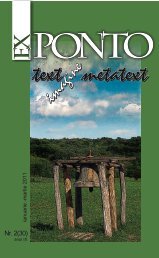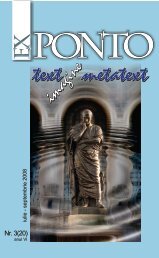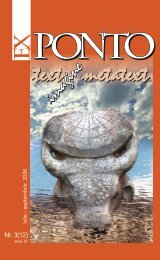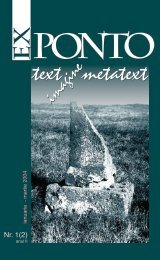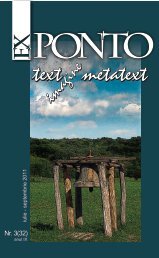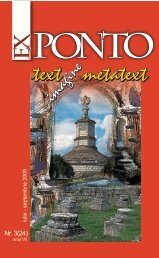Nr. 4 (21) anul VI / octombrie-decembrie 2008 - ROMDIDAC
Nr. 4 (21) anul VI / octombrie-decembrie 2008 - ROMDIDAC
Nr. 4 (21) anul VI / octombrie-decembrie 2008 - ROMDIDAC
You also want an ePaper? Increase the reach of your titles
YUMPU automatically turns print PDFs into web optimized ePapers that Google loves.
during the nineteenth century and the main source for the national budget<br />
was the export of cereals. The entire rural environment was exhibited at the<br />
world’s fairs: models of peasants’ houses from different provinces, costumes,<br />
and ethnographical objects. At the 1889 Paris World’s Fair, the Romanian<br />
authorities built a wooden inn, decorated with folk carpets, and pottery, where<br />
customers could try Romanian drinks and food. In 1900, the pavilion was<br />
designed as a piece of Romanian-Byzantine architecture which reminded the<br />
visitors that Romania had a primarily orthodox population. Some of Queen<br />
Elizabeth’s artifacts were also exhibited on that occasion. Her pen name,<br />
Carmen Sylva, drew attention to the Roman heritage of the Romanians and<br />
to the Latinity of the Romanian language. It was the 1937 pavilion built for<br />
the Berlin fair, the one which emphasized a religious message and historical<br />
symbols in a combination intended to suggest sweeping economical changes<br />
and the vital, organic energies of the people. It is important to mention that<br />
Romania was awarded 236 distinctions, mostly for the success of presenting<br />
such a convincing synthesis between the traditional culture and the modern<br />
civilization. The direct impact of official Romanian culture on the Americans<br />
was during the New York fair in 1939 when Romanian House simulated a<br />
rural orthodox monastery. What mostly impressed the American public was<br />
authentic folk culture:<br />
Within the pavilion were displays of Romanian textiles, ceramics,<br />
rugs, furniture, painting, and sculpture, used primarily as a setting for a<br />
Romanian restaurant serving food prepared by chefs from Bucharest to<br />
the accompaniment of Gypsy violins. 6<br />
Henri Matisse’s Romanian Blouse Series<br />
The Romanian folk costume had become so fashionable in Paris during<br />
the 1920s because the Queen of Romania insisted on wearing it, that Henri<br />
Matisse started collecting Romanian blouses alongside with other exotic<br />
textiles from Africa, India, and the Middle East. It is also said that Constantin<br />
Brâncu[i, the famous avant-garde sculptor, wore peasant clothing and<br />
elaborated on its geometrical motifs in his abstract art.<br />
From 1936 to 1942, Matisse drew and painted several versions of the<br />
Romanian blouse, using professional models. They posed as if they were to<br />
illustrate a fashion magazine in which the garment is more important than the<br />
model. Unlike other series in which exotic clothing are depicted, the Romanian<br />
blouse series focuses more on the blouse itself.<br />
Henri Matisse, Romanian Blouse, 1940<br />
The portraits combine different decorations<br />
with different postures: the meditative posture<br />
is matched with the green blouse with floral<br />
motifs on its sleeves in The Green Romanian<br />
Blouse (1939); the recumbent position goes<br />
with the geometrical angular patterns in The<br />
Dream (1940). 7 The drawings from 1936, 1939,<br />
and 1942 display the same awareness of the<br />
models of being admiringly looked upon and<br />
consequently they expose their sensuality<br />
EX PONTO NR.4, <strong>2008</strong><br />
113




